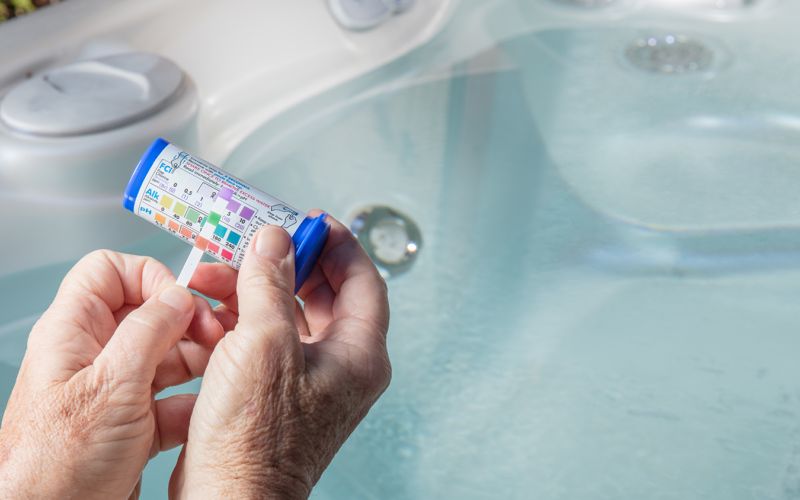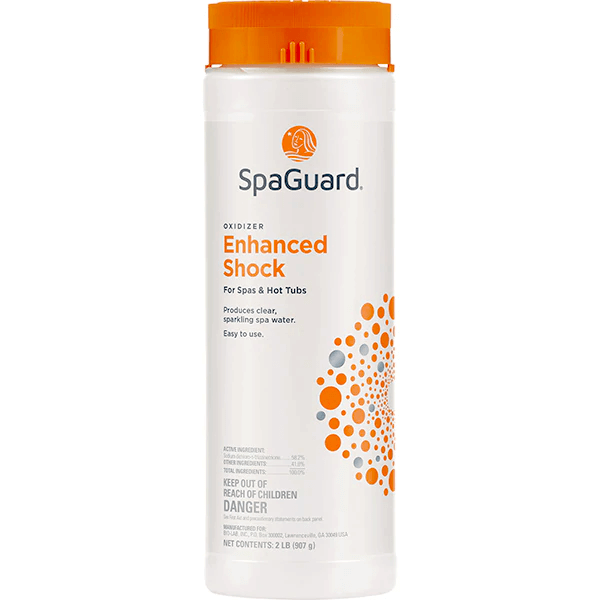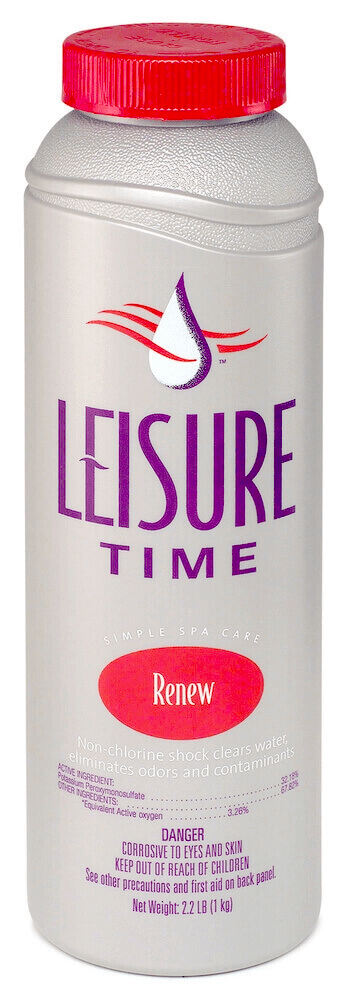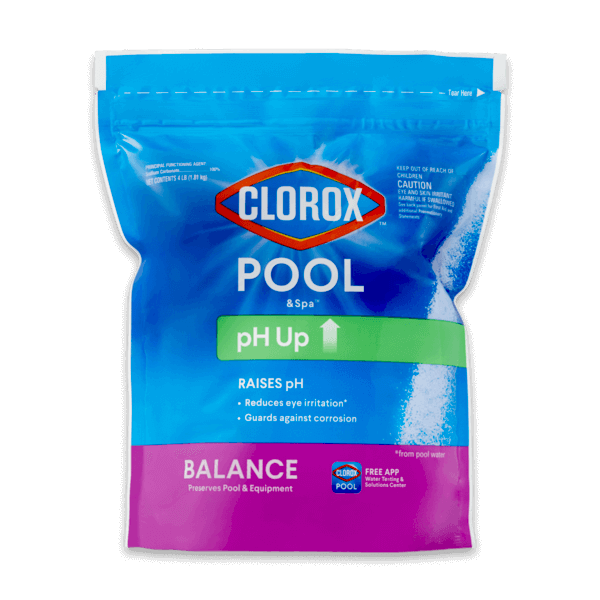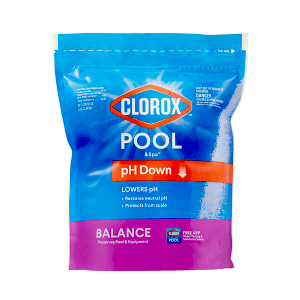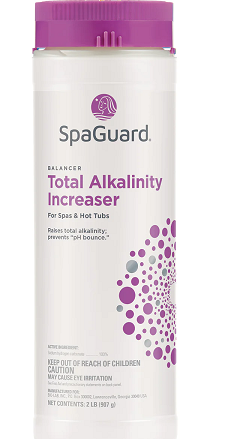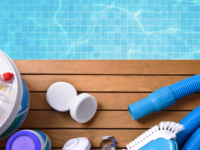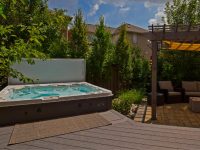After buying a new inflatable hot tub, you will inevitably face the need to keep it clean and well-maintained. For an inflatable hot tub to last years round, it is essential to have basic care chemicals on hand. But how many of them do you need?
Few would want to spend money on unnecessary chemicals and then try to figure out where to store them all. Moreover, reading about the technical aspects of chemical levels or how they affect each other can puzzle even more.
Don’t think of chemicals as a bad thing when it comes to the care and maintenance of your hot tub, they are here to help you, not hurt you. In our article, we will introduce you to the right chemicals for your inflatable hot tub, simple and clear.
Must-Have Chemicals for an Inflatable Hot Tub
Inflatable pools are a great option as they are lighter and more affordable compared to other types of hot tubs. However, they still require the same maintenance as portable, above-ground, and in-ground hot tubs.
In the table below, you will find a list of absolutely must-have chemicals that our research team has selected from hundreds of similar ones. We have also described what chemicals you may need for specific cases in another section.
How Did We Choose?
Our research team analyzed over a thousand customer reviews, focusing on essential criteria like water compatibility, sanitization effectiveness, pH regulation, and overall product quality. This thorough examination led us to identify the most reliable and effective hot tub chemicals for optimal maintenance.
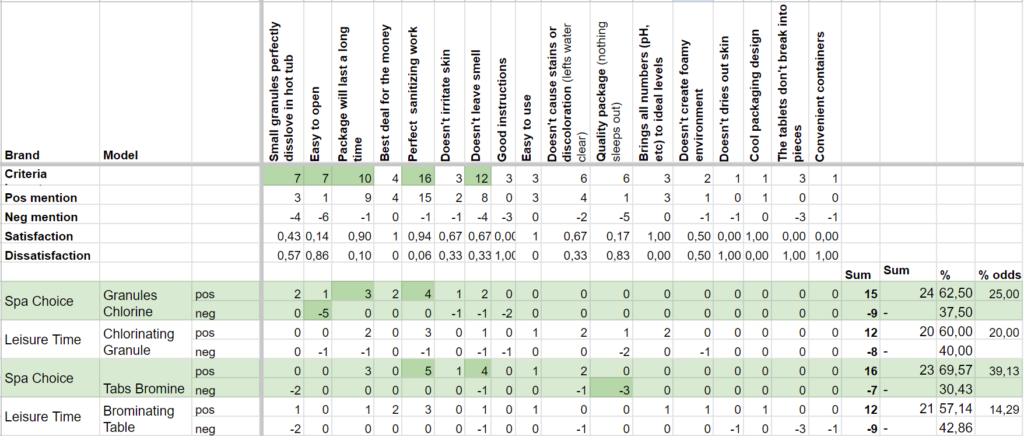
We search for popular and high-quality products, with a strict policy of discarding any outdated models, options with low ratings, and products with negative reviews.
ByRossi’s team approach is focused on analyzing both positive and negative reviews, extracting quality criteria, and evaluating the results to identify the top 3–5 products. The next step is to ensure we can safely recommend selected products for purchase by testing them out.
We believe in the power of comparison to help readers prioritize and choose the best product for their needs.
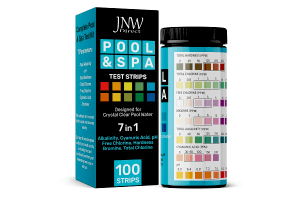 JNW Pool and Spa Test Strips 7 in 1 | |
Chlorine sanitizer is best for fast and affordable sanitizing. Bromine sanitizer is best for skin- and odor-sensitive people. | |
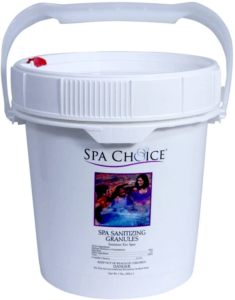 Chlorine granules Jump to the detailed review | |
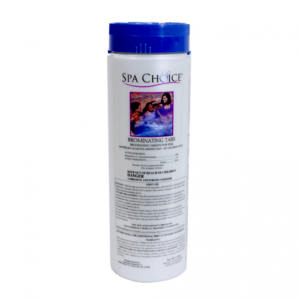 Bromine tabs Jump to the detailed review | |
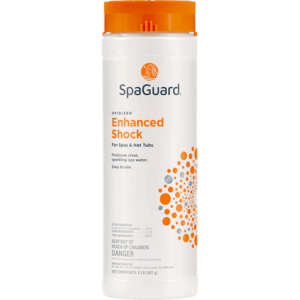 Chlorine Shock Chlorine ShockJump to the detailed review | |
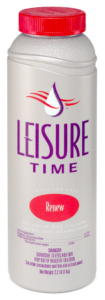 Non-chlorine Shock Non-chlorine ShockJump to the detailed review | |
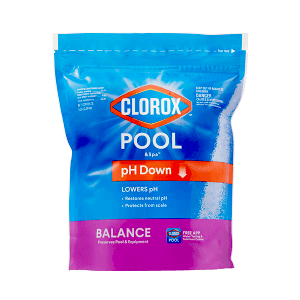 Clorox Pool&Spa pH Down Jump to the detailed review | |
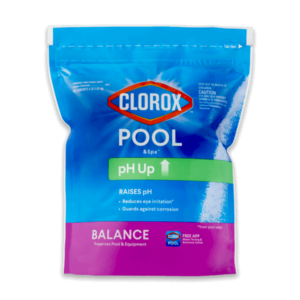 Clorox Pool&Spa pH Up Jump to the detailed review | |
Hot Tub Chemicals 101: The Basics
Since we don’t usually change the water in the hot tub after every other bath (otherwise our water bills would go through the roof), it needs to be regularly cleaned. This is why we use chemicals — to purify and balance the chemical elements in the water so it’s clean and safe to use.
The basic kit for maintaining the chemical balance of your inflatable hot tub should consist of these items:
- Test Strips
- Sanitizer (based on Bromine or Chlorine)
- Shock Oxidizer
- Clarifier
- pH Up & Down
It doesn’t matter how often you use your hot tub, whether seasonally or throughout the year. But before each use, you need to make sure the water is clean and safe for your body. A little further on, we talk about all the important water indicators.
Sanitizers Review: Chlorine VS Bromine
As we mentioned earlier, sanitizer is important to keep your hot tub clean and hygienically safe. The two most popular types of these substances are chlorine and bromine sanitizers. Both are effective, but they work differently. We’ve created a little comparison chart to make it clear.
| Chlorine | Bromine |
| ✔️ Gives the fastest effect ✔️ It’s the most affordable option ✔️ Easier to use than bromine | ✔️ Best choice for sensitive skin ✔️ It’s odorless ✔️ Requires less amount at once to keep your hot tub clean |
| ❌ Usually leaves a pretty strong scent ❌ Can irritate your skin and eyes ❌ It can disrupt pH levels | ❌ It’s pricey ❌ Sensitive to the sun (if you have a hot tub without a cover, bromine will not work for you) ❌ Takes longer to get the effect |
As you can see, both chlorine and bromine sanitizers have their nuances and positive aspects. Depending on the individual characteristics of your body and your hot tub, one or the other may be right for you.
That’s why we’ve researched the sanitizer market and found two models that we think are the highest quality and worth your attention.
Spa Choice Granules Chlorine — the Best for Fast and Affordable Sanitizing

Pros
- The fastest effect as it sanitizes in five minutes to 12 hours, up to 240 times faster than bromine
- The best deal for money
- Does decent sanitizing work
- Small granules perfectly dissolve in the hot tub
Cons
- The package is not easy to open
- If you have sensitive skin, it can irritate it a bit
- Instructions are not very clear
If you need a sanitizer that is fast-acting and easy to use, then Spa Choice Granules Chlorine is a great option. Chlorine granules dissolve quickly in water and effectively clean it, protecting it from bacteria and algae. This is also the most affordable sanitizer available today. If your hot tub does not have a cover, chlorine is the only option as it is sun-resistant, unlike bromine.
However, the only disadvantages of this product are its incompatibility for people with odor sensitivity and sensitive skin, as well as its inconvenient lid. It may be difficult to open at first since Chlorine is quite poisonous, and such an intricate clasp ensures that children cannot open the sanitizer accidentally or intentionally. Fortunately, there are detailed explanations and even videos available online.
How to use it?
If you are using your hot tub for the first time, it is recommended that you add 6 teaspoons of Spa Choice Granules Chlorine
per 500 gallons of water. After that, check the with test strips. If the reading is below 4-5 ppm, add more chlorine. Once the FAC is down to 3-5 ppm, you can start using your hot tub.
When maintaining the cleanliness of your hot tub, the rules are almost the same, but you should use 3 teaspoons per 500 gallons of water.
Spa Choice Tabs Bromine — the Best for Odor Haters with Sensitive Skin
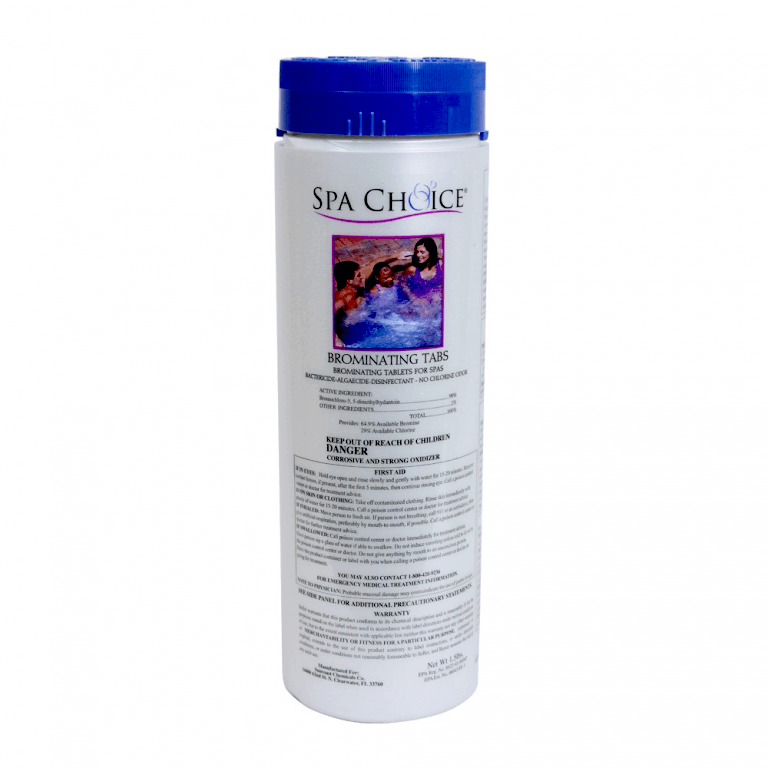
Pros
- Best fit for sensitive skin
- Doesn’t have any fragrance
- Perfectly clears the water
- Don’t mess up with pH levels
Cons
- Some customers complain about loose packaging
- It’s pricey
- Breaks down under the sun
is there for you. The more expensive cost of bromine is offset by the fact that the same amount of bromine lasts longer, so you don’t have to worry about it.
It’s easier to use because it’s more stable in hot water and retains its residual content longer. When the bromine completes the disinfection cycle, it remains dormant in the water. Just add a little shock and the bromine will continue its disinfecting work. It is also more gentle on the skin than chlorine, but just as effective at cleaning.
Bromine also has its disadvantages. It works a little slower than chlorine and is not resistant to the sun. That is, you should cover your hot tub when using it. Also, a few customers have complained about a weak lid, but these are quite rare cases.
How to use it?
Bromine is different from chlorine in use. It comes in Spa Choice as tablets, and you have to put the tablets in the feeder or automatic brominator installed in the hot tub (if you have it). It is advised to put 3 tabs in your feeder or brominator per 300 gallons of water. You can enter a hot tub when the bromine level falls to 2–5 ppm.
For maintaining your hot tub, add 3 tablets per 300 gallons when they’re over, and that’s it. The owners say it lasts about a month, so keeping it clean becomes a walk in the park.
Oxidizers AKA Shock — What and Why?

Shocking or oxidizing is a helpful procedure for an inflatable hot tub and is recommended once every 1–2 weeks (depending on the frequency of use). Shock is a very strong chemical that destroys any contaminants that make the water muddy or dirty. That is, it is often used when chlorine or bromine fails, but it’s not an everyday thing.
As we have already mentioned, the shock reactivates dormant bromine or chlorine and makes it work again.
❗Be careful: be sure to read the instructions before using the shock so as not to go overboard the amount.
Shocks are usually chlorine and non-chlorine. Chlorine shocks are combined with chlorine sanitizer, and non-chlorine shocks are suitable for bromine sanitizers. They are equally effective when combined with appropriate sanitizers.
⚠️ Be careful: Mixing chlorine shock with bromine sanitizer or bromine shock with chlorine sanitizer generally won’t cause harm. However, it can lead to chemical reactions that don’t produce the desired results. In the first case, chlorine may enhance bromine’s effect, and in the second case, bromine may accumulate in the hot tub.
We can recommend SpaGuard Enhanced Shock if you have chlorine sanitizer & need chlorine shock, and Leisure Time Non-Chlorine Shock if you have bromine sanitizer & are looking for a non-chlorine one.
Water Tester — All Indicators that Need to Be Tested
Water testing is the first thing you should do before adding any chemicals to your water. This is necessary to understand what basically should be used because if your pH is normal, you don’t need to deliver a pH Increaser or Decreaser.
in water for a few seconds and see what colors the fields turn. Then you simply compare them to the ones drawn on the box to understand the levels of bromine, chlorine, etc.
It is best to test the water 3 times a week to monitor the condition and, if necessary, adjust the levels with the necessary products.
Here we’ve created a handy table for you. Feel free to save it so you can easily check what levels are best for the water in the hot tub.
| Guidelines for optimal hot tub chemistry | ||
| Water indicator | Ideal Range | Products to adjust |
| Free Chlorine | 3 to 5 ppm | Spa Choice Granules Chlorine |
| Bromine | 2 to 5 ppm | Spa Choice Tabs Bromine |
| Total Alkalinity | 80 to 120 ppm | SpaGuard Spa Total Alkalinity Increaser |
| pH | 7.2 to 7.6 ppm | Clorox Pool&Spa pH Up Clorox Pool&Spa pH Down |
| Calcium Hardness | 200 to 400 ppm | SpaGuard Spa Calcium Hardness Increaser |
pH Levels
The pH is the indicator that determines the acidity or alkalinity of water. The pH can range from 1 to 14, where 1 is acidic and 14 is extremely alkaline. But as we know, extremes are not what we need. The neutral level on the scale is 7, but water should ideally be slightly alkaline. That’s why the sweet spot for pH is between 7.2 and 7.6.
What are the risks of deviations?
If the pH is low (acidic), you will be uncomfortable in the hot tub in the first place. Acidic water will sting your eyes, and it is bad for the tub itself in that it can start corroding metals.
High pH will sting your eyes and cause itching, too. But it can also make the water cloudier and murkier, and scale can spread on the filters, jets, and other elements of the hot tub. The pH level in your hot tub will not necessarily always be higher or lower than normal. But if it is, we suggest using pH Increaser or pH Decreaser depending on the situation.
Alkalinity
Total alkalinity is closely related to pH. We won’t go into the maze of science so as not to confuse you, and we’ll explain in simplified terms. The higher the alkalinity, the higher the pH — you remember the consequences. Plus, it works the same way in reverse. So adjusting your alkalinity is something you need to do before you move on to pH levels.
If the testers show low levels of alkalinity, we recommend using SpaGuard Spa Total Alkalinity Increaser — it does its job perfectly. And if you need to reduce the overall alkalinity in your hot tub, pH Decreaser or hydrochloric acid can help. Unfortunately, the pH Decreaser trick only works one way. You still need an Alkalinity Increaser because, in a situation where pH is normal and alkalinity is down, you need an Alkalinity Increaser as it doesn’t affect pH.
Calcium Hardness
The last indicator worth paying attention to is calcium. Usually, its level is normal or below normal. If it is lower, you should use SpaGuard Spa Calcium Hardness Increaser. Low calcium levels contribute to the fact that the water begins to corrode different parts of the hot tub — heater, massage system, etc. Therefore, if you see a result below 120 ppm on the test strip, we recommend using a calcium increaser.
Extra Chemicals You May Need
If for some reason your water becomes muddy and dirty, and you can not or do not want to use a shock, there is a special product for clearing the water, which is the so-called clarifier. We think the Leisure Time Cleanser is one of the best models for the job.
Another thing you might need is a foam remover. Yes, the foam in your hot tub can be annoying. It can come from substances you use (shampoos, shower gels) or sometimes from sanitizers. It can also be mixed with disgusting particles of dirt from your skin, or particles of oils, deodorants, or whatever.
The bottom line is that the water will be contaminated, which is not what we’re going for. If you’re facing a foam problem, we suggest using Leisure Time Foam Down Cleanser — it’s already proven to be effective and has received hundreds of positive reviews on Amazon.
Chemicals Cost and How To Save Up
The question of money is, as always, one of the most important. Many people worry that maintaining a hot tub will cost too much and it’s not worth buying one because of that. Let us try to dissuade you: this is not true, because you will not use most of the chemicals regularly. The most important ones are, in fact, sanitizers and test strips, because they are really in use almost daily.
For example, if you have an inflatable hot tub with 500 gallons of water, you should expect $40-$45 in chemical costs, assuming your chemical levels are in order, and you just need to keep the water clean.
It’s hard to save money on chemicals because if you don’t use them, it can cost you more in the long run. But we do have some tips:
- It’s better to buy large packages of chemicals, especially if you’re sure of the brand — it’s usually more cost-effective.
- You can consider buying chemical kits as they include all the necessary chemicals for the hot tub’s maintenance. Moreover, you can save up to 20% of the cost compared to buying each chemical separately. Below, we’ve listed the three possible options from reliable brands:
- If you don’t use the hot tub for some months, it’s better to drain the water — that way you’ll save on both chemicals and electricity.
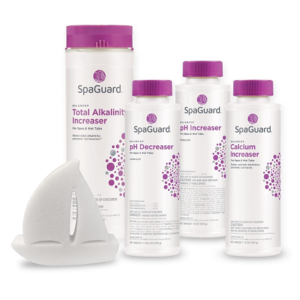 SpaGuard Chemical Balancer Maintenance Kit | How much do you save? 15% = $10 Kit Scum absorber pH increaser pH decreaser Total alkalinity increaser Calcium hardness increaser 50pcs test strips (5-way) |
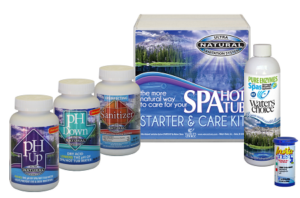 Waters Choice Hot Tub Chemicals Starter Kit | How much do you save? 14% = $13 Kit Pure enzymes for spas pH increaser pH decreaser Sanitizer 50pcs test strips (4-way) Instructions for using Waters Choice enzymes |
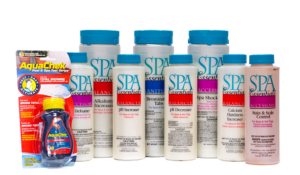 Leisure Spa Essentials Bundle Package Kit | How much do you save? 19% = $40 Kit Defense pH increaser pH reducer Foam reducer Re-energizer Bromine sanitizer Bromine booster Metal-free Calcium increaser 10pcs test strips Floating dispenser Spa care guide |
Summary
Keeping water and equipment clean is not as difficult as it seems. All you have to do is understand all the chemicals for inflatable hot tubs once, and you already feel like a pro, right?
Test the water, then use sanitizer and (less often) shock, and add other chemicals like pH Increaser/Decreaser, and Alkalinity Increaser to get well-balanced levels. Foam Remover and Clarifier are not that necessary. You should apply it only if you face corresponding problems. As simple as ABC, right? Just choose the proper products and enjoy your hot tub all year round.
FAQ
🧴 What Chemicals Are Needed for Inflatable Hot Tubs?
Usually, you need sanitizer (chlorine or bromine), water test strips, and a shock oxidizer. Depending on your water condition you may also need pH increaser/decreaser, alkalinity increaser , and calcium increaser. Extra chemicals that might be useful are foam remover and clarifier.
❓ How Do I Add Chemicals to My Inflatable Hot Tub?
First of all, you should test your water indicators. Then, depending on the results, you can add pH increaser/decreaser, alkalinity increaser, or calcium increaser (follow instructions!). Sanitizers people usually add after every hot tub use. But anyway read instructions for every chemical you use to ensure everything is done properly.
💧 How Do You Keep Inflatable Hot Tub Water Clear?
Use your chlorine or bromine sanitizer to maintain the water clear in an inflatable hot tub. They kill bacteria and algae and keep the clearance in the tub. Also, use shock once in 1-2 weeks for super-cleaning.
🛁 What Chemicals Should I Put In My Hot Tub for the First Time?
For the first time, you will definitely need a sanitizer. It’s better to take pH increaser, pH decreaser, and calcium increaser as well, but test your water first to find out what you need to add.
💦 How Soon Can You Use the Hot Tub After Adding Chemicals?
It’s all individual, but you usually have to wait a few hours at least. To be confident, test the water and ensure all readings are normal before using your hot tub.
